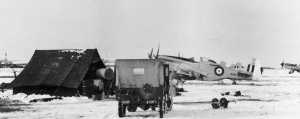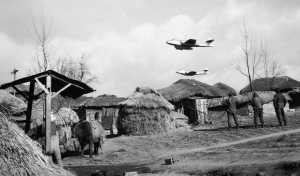Just a week into the Korean War, airmen of 77 Squadron, who had been stationed in Japan with the British Commonwealth Occupying Force (BCOF), were flying ground-attack missions and bomber escorts from Iwakuni, Japan.
The squadron moved from Japan to a succession of bases in Korea as the UN forces advanced and then retreated - Taegu, Pohang, Hamhung (North Korea), Pusan and Kimpo. The squadron was praised for its skill and courage during thousands of flights made during the war.

RAAF Mustang aircraft in the snow on the flight line, North Korea, November 1950. (AWM P0675/127/069)
Like to copy this image? Please click here first
After the success of the Inchon landing, the air force provided crucial support in relieving some of the pressure on ground troops. Pilots from 77 Squadron ranged far and wide over the Korean peninsula, providing cover for the advancing US Eighth Army as well as making their own attacks on North Korean forces. Many bombing attacks severely disrupted the progress of enemy ground forces. The main targets for air attack included North Korean railway lines, roads, military installations and vehicles. Initially pilots were equipped with propeller-driven P-51 Mustang fighters used during the Second World War; their weapons were bombs, rockets, machine-guns and napalm.
Although the combined UN forces' air power was superior to North Korea's, the entry of the Chinese into the war made the situation in the air more complicated. They too had air power, and to the dismay of the UN forces, superior aircraft - MiG-15 jet fighters. In response, 77 Squadron had to switch from flying Mustangs to Meteor jets.

RAAF Meteors skim over a Korean village as they head for their targets in North Korea. (AWM JK0612)
Like to copy this image? Please click here first
Chinese ground forces were more skilled than the North Korean forces in avoiding the damage caused by UN air power.
They were more mobile, better camouflaged, better able to cross large distances quickly, and were less reliant on supply networks, scrounging for food and other supplies as they travelled.
At times the weather was just as hazardous to pilots as flying under attack. Taking off was difficult in winter: thick ice and snow had to be removed each morning from the aircraft. In the event of ditching in the sea, pilots' immersion suits gave them only a few minutes to be rescued before the freezing water temperature would kill them. The heat of summer created problems as well: sometimes bitumen would melt onto the underside of aircraft during takeoff and landing. The humid summer haze extended into the atmosphere up to 1,000 metres, cutting visibility to less than three kilometres.
Despite their successes, during three years of operations 77 Squadron paid a high price. Forty pilots were killed - 30 killed in action, eight in accidents, and two in accidents on the ground. Six were captured and became POWs. Of the squadron's 90 Meteors, 54 were lost during the war.
(Extract from Out in the Cold, The Australian War Memorial's online exhibition on Korea)





